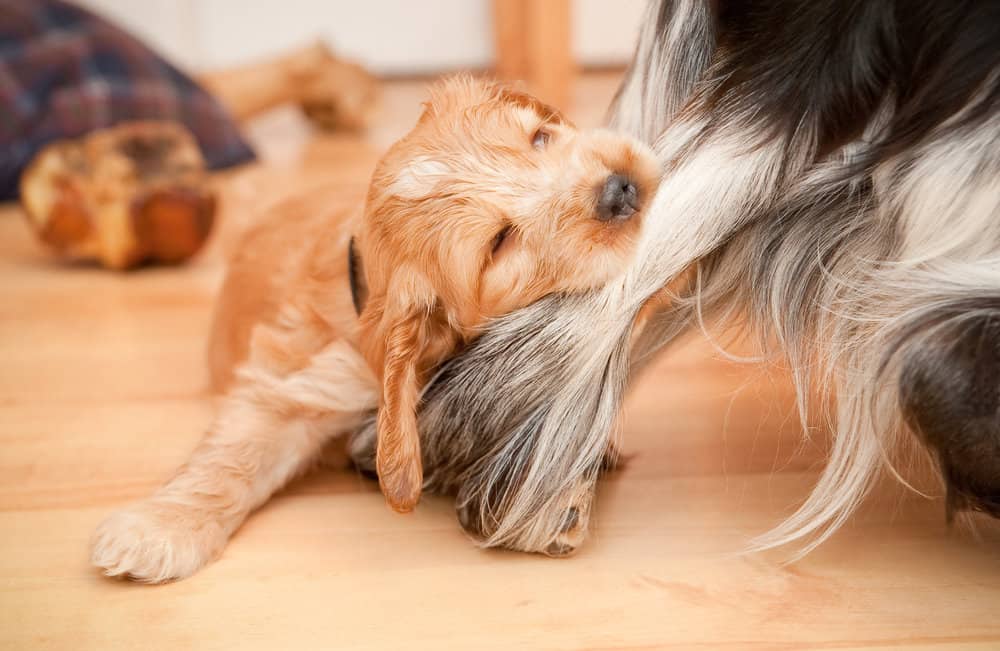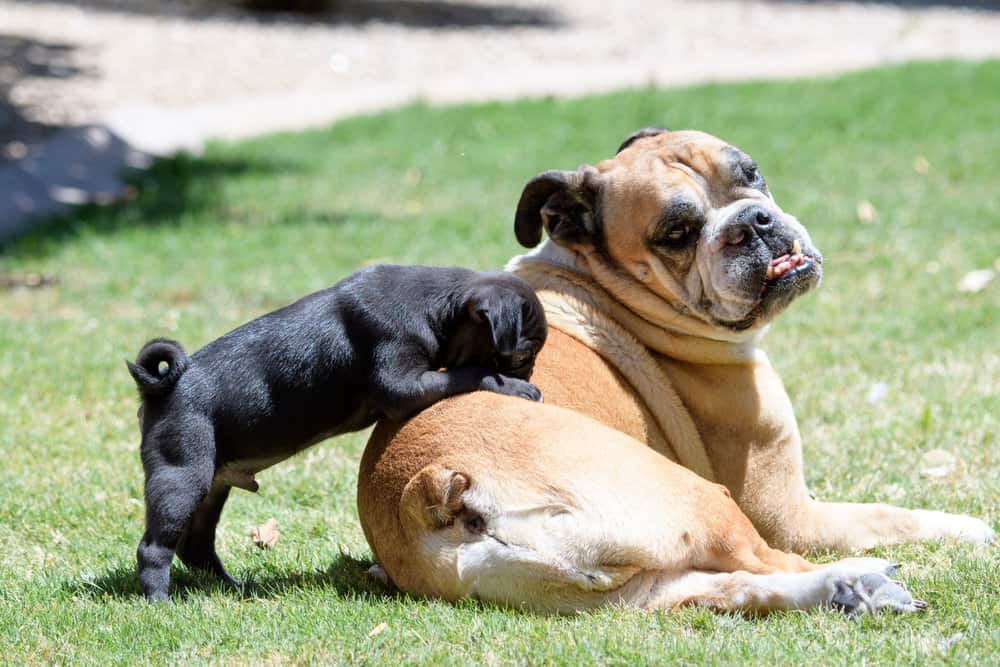To keep a puppy from biting older dogs, you need to keep the hierarchy in check. You can also try clicker training and exercise to distract the young pup from roughhousing and disruptive behaviors.
Figuring out how to stop a puppy from biting older dog playmates can be challenging for many new pet parents. Yet, it’ll all be worth it in the end when you maintain a healthy and peaceful relationship between your dogs.

Why Does My Puppy Want to Bite My Older Dog?
Let’s take a look at a few reasons why you might find yourself in that situation:
- The Puppy Is Demanding Attention
Most of the time, a puppy wants attention and stimulation to remain engaged and in good spirits. You need to pet and show affection to the puppy to help him grow mentally healthy.
If you have an older dog, he might become the target of the puppy’s pleas for attention. This can be as harmless as running around in circles or escalate to rough play or biting.
Helpful Dog Training Resource:
For help with training your dog, you should take a look at The Online Dog Trainer by Doggy Dan. Doggy Dan is an expert Dog Trainer based in New Zealand. His online resource contains Hundreds of Excellent Dog Training Videos that will take you step-by-step through the process of developing a healthy, happy well-behaved dog.
- You’re Not Giving the Puppy Adequate Exercise
Puppies are notoriously energetic, especially Siberian Husky, Golden Retriever, and Border Collie. They need enough exercise to use all that pent-up energy and be less annoying to other pets.
Nipping or biting could be their way of playing or keeping themselves occupied.
If you’re too busy to spend time training and exercising your puppy, that energy will need to go somewhere. Unfortunately, he’ll probably get the zoomies and end up treating your older dog as a chew toy.
- The Puppy Wants to Be the Pack’s Alpha
Dogs are pack animals, and the owner should act as the pack leader in a multi-dog house setting. Among them, the dogs will allow one of them to come out on top.
Yet, a puppy doesn’t always realize his size and standing in the pack. Sometimes, he will use aggression to show the older dog that he’s stronger and more capable of leading the group.
In most cases, the older pup will squash those attempts early on.
However, you should still monitor the puppy’s attempts to establish dominance, so he doesn’t go too far. Otherwise, he could grow into a pattern of aggressive behaviors.
5 Tips to Stop a Puppy From Biting an Older Dog
Let’s go over the common ways that can help you control a puppy who won’t stop bothering his older playmate:
- Let the Older Dog Handle the Situation

Typically, this is what most trainers will advise you to do first. Older dogs might wait patiently, but they can stop an annoying puppy if his behavior gets out of hand.
It’s almost like how an older relative teaches a young child proper manners. They could use hushed tones at first, but they can also be stern if they need to be.
You might think the older dog is being aggressive if he tries to stop the puppy, but you shouldn’t. Instead, try to avoid correcting or yelling at your older dog because this tells the puppy he’s on the right.
The older dog can protect himself by:
- Growling
- Taking away one of the puppy’s toys
- Leaving the room when the puppy starts getting rowdy
All of these are examples of normal behavior, and you should let them sort it out among themselves. However, if your older dog is too frail or sick to defend himself, then you might need to intervene.
- Distract Your Puppy From the Older Dog
Distracting your puppy can prove very effective in preventing any serious roughhousing incidents.
You can do this by paying attention to your puppy’s movements and stepping in when he shows aggression.
The common warning signs to watch out for are:
- Narrowed gaze
- Cowering
- Flattened ears
- Curled lips
If you follow the clicker training method, call on the puppy and use the clicker when he looks at you. Saying things like “good job” or giving him a treat when he ignores the older dog can also be effective.
It could take a while, but the puppy’s behavior will improve with enough distraction training.
- Wear Out Your Puppy With Enough Exercise

If you notice too many destructive behaviors besides the biting, then you probably have an under-stimulated puppy.
Take the pup on walks, give him puzzle feeders or hurdles to jump, and just keep him preoccupied. This should take care of the boredom that leads to unnecessary aggression.
However, if the puppy still bites or pesters his playmate after exercising, you need to step things up a bit.
- Establish Clear Boundaries and Pack Roles
Ideally, the older dog should come out on top of the dog hierarchy.
That means the older dog gets his bowl first, goes out the door first, and so on. These should be enough to teach the younger pooch how the hierarchy goes.
If the older dog relinquishes his leadership role, that doesn’t mean you should allow the puppy to step over him. Instead, teach him to respect the older dog, be quiet when he needs to, and share his toys when playing.
Don’t forget to reward your pup when he’s being civil and follows the boundaries you set for him.
Helpful Dog Health Resource:
Note: Our Health is #1 Priority. It should be no different for your dog. But you need to help him. The Ultimate Guide to Dog Health is the answer. This handy guide will help you recognize the symptoms of the health problems above. Get the knowledge to stay ahead of these terrible issues that can rob your lovely dog from vigor and life. Help your friend make it to 14 yrs+ without pain and suffering.
- Separate the Dogs If Necessary
In most cases, a firm “stop that” or “no biting” should prevent the nipping attempts of a rowdy pup. But sometimes, the puppy won’t relent, and the older dog might lose his patience.
If it gets too crazy at home, you’ll have to separate the two dogs using crates or dividers.
This might sound extreme, but it teaches the puppy that it’s not okay to overstep his boundaries.
That’s the time you’ll get to spend alone with the pup. So, use this opportunity to train him to calm down and use one of the distraction exercises mentioned above.
When you reintroduce the two dogs to each other, keep a close eye on them both to avoid any fights. If they play nice with each other, offer them both treats and a toy to each for positive reinforcement.

Paul has been creating content for the dog niche for many years. The information he shares comes his first hand experience growing up in dog lovers household and then owning multiple dog breeds of his own as an adult. Paul enjoys doing the hard research to collect, analyze and present our dogtemperament.com readers with the best answers to their questions.